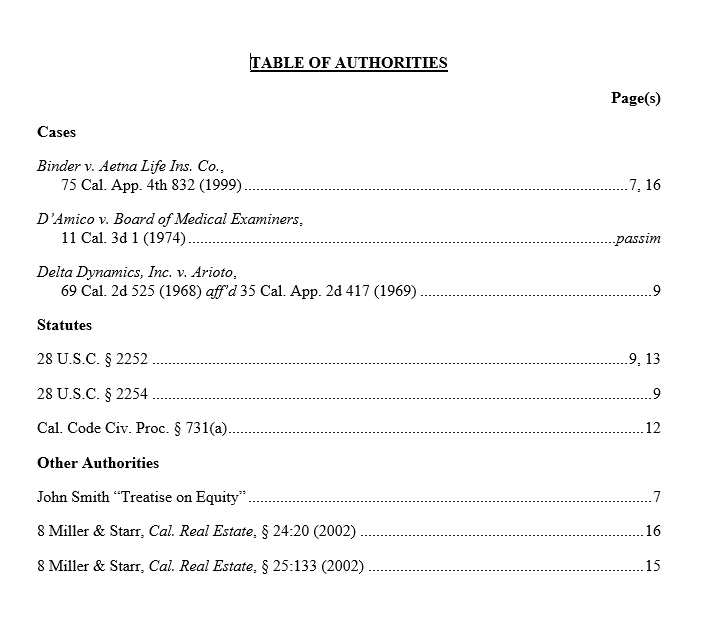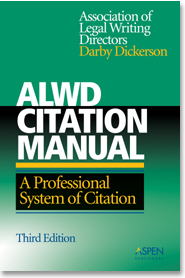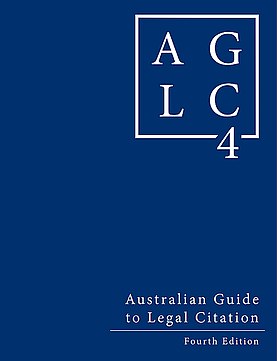Sample
Here is a sample table of authorities:

A table of authorities is part of a legal brief that contains an index of the cases, statutes, and secondary sources cited. This article deals specifically with the characteristics of tables of authorities in the United States. The table of authorities, often called a TOA, is frequently a legal requirement for litigation briefs; the various state courts have different rules as to what kinds of briefs require a TOA. The TOA list has the name of the authority followed by the page number or numbers on which each authority appears, and the authorities are commonly listed in alphabetical order within each grouping. The intention is to allow law clerks and judges to easily and rapidly identify and access the legal authorities cited in a litigation brief.
A table of authorities is also sometimes called a table of cases or a table of citations.
The "Bluebook: A Uniform System of Citation" is relied upon in many jurisdictions to provide rules for citing legal authorities. [1]
The "California Style Manual" has been adopted by the California Supreme Court as the official guide for styling citations in their state. [2]
The Texas Greenbook is the guide to rules for citing legal authorities in that state. [3]
Other states may have their own style manuals.
A table of authorities can be grouped in different ways. A common grouping is to list the authorities according to the categories: cases, statutes and other authorities. Other variations (among many others) include, for example, dividing cases into federal cases and state cases, and dividing statutes into state and local.
Here is a sample table of authorities:

In four states: Illinois, Oklahoma, Kentucky and Kansas, the state courts have different formatting requirements than the other states. These states require a table of "Points and Authorities", which is a mixing together of the table of contents and table of authorities. In this format, the authorities are listed under each issue presented for review. A table of points and authorities serves as a table of contents for the argument section of a brief, followed by a list of the cases and statutes upon which the brief relies.
Some states require the authorities that appear in each section of the document to be listed in the order in which they appear. [4] Another variation, for example, required by the Supreme Court of Illinois, is that the "Cases shall be cited as near as may be in the order of their of their importance." [5]
The First and Eleventh District Courts of Appeals in Ohio require that under each issue presented for review, the brief shall list alphabetically, in a further indented subparagraph, the cases cited in support of the issue, followed by a list of the statutes, rules, and other authorities cited in support of the issue. [6] [7]
Here's an example of a table of points and authorities, in which the authorities are listed in the order in which they appear in the document, under each section of the table of contents:

Some courts, including the U.S. District Court for the District of Columbia and the U.S. Court of Appeals for the Eleventh Circuit, require that an asterisk be placed in the margin to the left of the primary authorities relied upon in the brief. [8] [9]
Leading word-processing software, including Microsoft Word and its competitor WordPerfect, have built-in capabilities to semi-automate the creation of a table of authorities. [10] These programs can create tables based on user-marked citations. Even so, creating a table of authorities using Word has been said to "strike ... fear into the hearts of legal support staff" and has been called "intimidating". [11] The process of formatting citations is called "confusing", "frustrating" and "time-consuming". [12] The book "Legal Writing" calls the table of authorities "complicated" and says "it takes more time than you might imagine". [13]
To simplify the process further, other applications and plug-ins for word processors provide similar functionality as well as additional features such as automatically finding and marking citations in the document. For example, Lexis for Microsoft Office integrates with the LexisNexis research platform and can check whether the citations conform to the rules of the jurisdiction and provide alerts that indicates when a cited case has been questioned or overruled by a later decision (known as "Shepardizing" the citation). [14]
Other software products to assist with creating Tables of Authorities include:

An affidavit is a written statement voluntarily made by an affiant or deponent under an oath or affirmation which is administered by a person who is authorized to do so by law. Such a statement is witnessed as to the authenticity of the affiant's signature by a taker of oaths, such as a notary public or commissioner of oaths. An affidavit is a type of verified statement or showing, or in other words, it contains a verification, which means that it is made under oath on penalty of perjury, and this serves as evidence for its veracity and is required in court proceedings.
In legal terminology, a complaint is any formal legal document that sets out the facts and legal reasons that the filing party or parties believes are sufficient to support a claim against the party or parties against whom the claim is brought that entitles the plaintiff(s) to a remedy. For example, the Federal Rules of Civil Procedure (FRCP) that govern civil litigation in United States courts provide that a civil action is commenced with the filing or service of a pleading called a complaint. Civil court rules in states that have incorporated the Federal Rules of Civil Procedure use the same term for the same pleading.
Precedent is a principle or rule established in a legal case that becomes authoritative to a court or other tribunal when deciding subsequent cases with similar legal issues or facts. The legal doctrine stating that courts should follow precedent is called stare decisis.

In computing, a hyperlink, or simply a link, is a digital reference to data that the user can follow or be guided to by clicking or tapping. A hyperlink points to a whole document or to a specific element within a document. Hypertext is text with hyperlinks. The text that is linked from is known as anchor text. A software system that is used for viewing and creating hypertext is a hypertext system, and to create a hyperlink is to hyperlink. A user following hyperlinks is said to navigate or browse the hypertext.
In law, a citation or introductory signal is a set of phrases or words used to clarify the authority of a legal citation as it relates to a proposition. It is used in citations to present authorities and indicate how those authorities relate to propositions in statements. Legal writers use citation signals to tell readers how the citations support their propositions, organizing citations in a hierarchy of importance so the reader can quickly determine the relative weight of a citation. Citation signals help a reader to discern meaning or usefulness of a reference when the reference itself provides inadequate information.

Case citation is a system used by legal professionals to identify past court case decisions, either in series of books called reporters or law reports, or in a neutral style that identifies a decision regardless of where it is reported. Case citations are formatted differently in different jurisdictions, but generally contain the same key information.
A brief is a written legal document used in various legal adversarial systems that is presented to a court arguing why one party to a particular case should prevail. Appellate briefs establishes the legal argument for the party, explaining why the reviewing court should affirm or reverse the lower court's judgment based on legal precedent and citations to the controlling cases or statutory law.

Westlaw is an online legal research service and proprietary database for lawyers and legal professionals available in over 60 countries. Information resources on Westlaw include more than 40,000 databases of case law, state and federal statutes, administrative codes, newspaper and magazine articles, public records, law journals, law reviews, treatises, legal forms and other information resources.

The Bluebook: A Uniform System of Citation is a style guide that prescribes the most widely used legal citation system in the United States. It is taught and used at a majority of U.S. law schools and is also used in a majority of federal courts. Legal publishers also use several "house" citation styles in their works.

ALWD Guide to Legal Citation, formerly ALWD Citation Manual, is a style guide providing a legal citation system for the United States, compiled by the Association of Legal Writing Directors. Its first edition was published in 2000, under editor Darby Dickerson. Its sixth edition, under editor Coleen M. Barger, was released in May 2017 by Wolters Kluwer.
Legal citation is the practice of crediting and referring to authoritative documents and sources. The most common sources of authority cited are court decisions (cases), statutes, regulations, government documents, treaties, and scholarly writing.
In United States law, multidistrict litigation (MDL) refers to a special federal legal procedure designed to speed the process of handling complex cases, such as air disaster litigation or complex product liability suits.
Electronic discovery refers to discovery in legal proceedings such as litigation, government investigations, or Freedom of Information Act requests, where the information sought is in electronic format. Electronic discovery is subject to rules of civil procedure and agreed-upon processes, often involving review for privilege and relevance before data are turned over to the requesting party.

The Australian Guide to Legal Citation (AGLC) is published by the Melbourne University Law Review in collaboration with the Melbourne Journal of International Law and seeks to provide the Australian legal community with a standard for citing legal sources. There is no single standard for legal citation in Australia, but the AGLC is the most widely used.
Microsoft has been involved in numerous high-profile legal matters that involved litigation over the history of the company, including cases against the United States, the European Union, and competitors.
Pro se legal representation comes from Latin pro se, meaning "for oneself" or "on behalf of themselves" which, in modern law, means to argue on one's own behalf in a legal proceeding, as a defendant or plaintiff in civil cases, or a defendant in criminal cases, rather than have representation from counsel or an attorney.

The Canadian Guide to Uniform Legal Citation is a legal citation guide in Canada. It is published by the McGill Law Journal of the McGill University Faculty of Law and is used by law students, scholars, and lawyers throughout Canada. The book is bilingual, one half being in English and the other in French.
In copyright law, the legal status of hyperlinking and that of framing concern how courts address two different but related Web technologies. In large part, the legal issues concern use of these technologies to create or facilitate public access to proprietary media content — such as portions of commercial websites. When hyperlinking and framing have the effect of distributing, and creating routes for the distribution of content (information) that does not come from the proprietors of the Web pages affected by these practices, the proprietors often seek the aid of courts to suppress the conduct, particularly when the effect of the conduct is to disrupt or circumvent the proprietors' mechanisms for receiving financial compensation.

The California Code of Civil Procedure is a California code enacted by the California State Legislature in March 1872 as the general codification of the law of civil procedure in the U.S. state of California, along with the three other original Codes. It contains most California statutes that govern the filing and litigation of lawsuits in the Superior Courts of California, as well as legal notices that must be given in a variety of circumstances. It also includes statutes of limitations that control the period of time during which a lawsuit may be commenced. The Code originally governed the legal profession, but those were later moved to the Business and Professions Code.
The Bipartisan Legal Advisory Group (BLAG) has been a standing body of the U.S. House of Representatives since 1993 that directs the activities of the House Office of General Counsel. BLAG can direct the General Counsel to participate in litigation or file an amicus curiae brief in cases involving the interests of the House or BLAG can call for legislation or a House resolution authorizing the General Counsel to represent the House itself. BLAG comprises five members of House leadership: